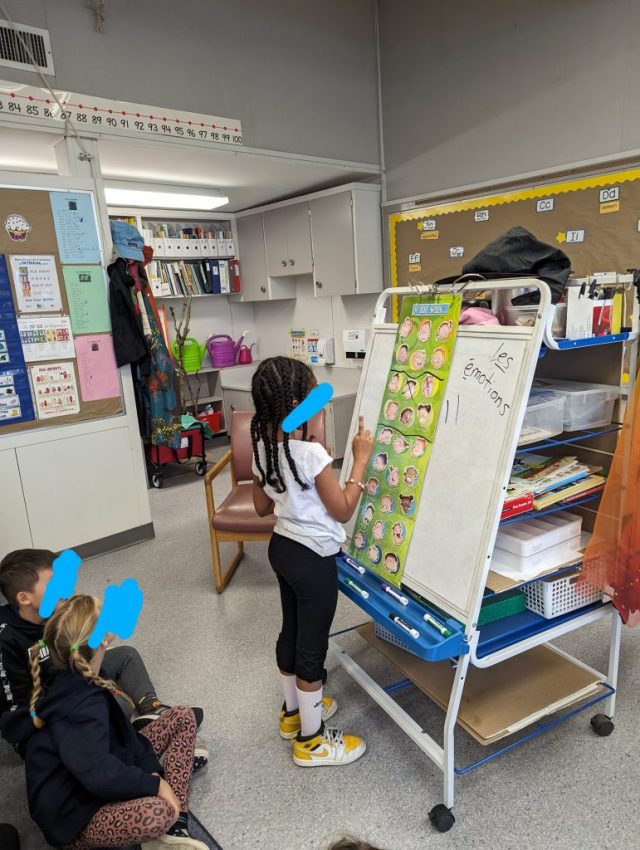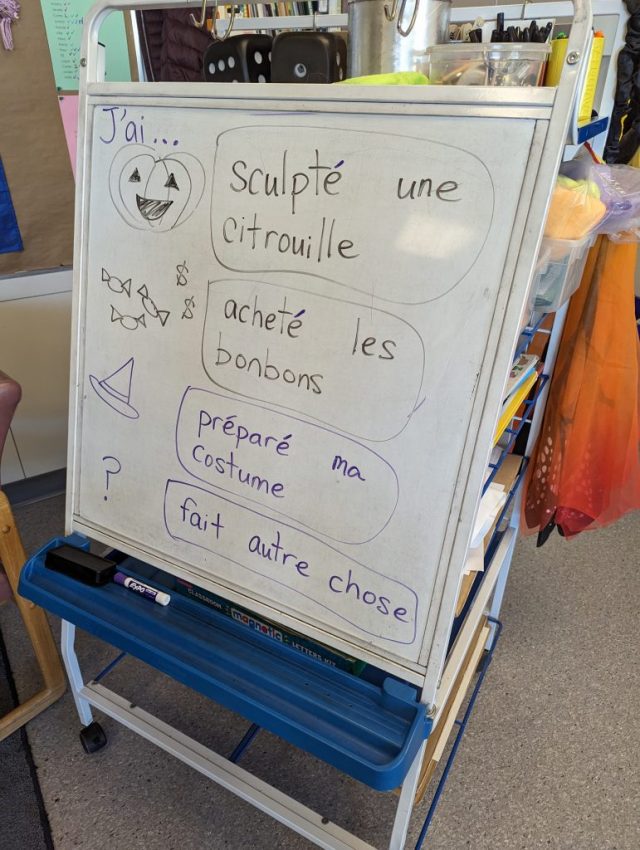Last week, students were asked to reflect on what gives them peace.
Here are their answers:
Learning adventures in a Grade 2 French Immersion classroom
Last week, students were asked to reflect on what gives them peace.
Here are their answers:

Students are learning to choose appropriate books for themselves. Every week, they’re encouraged to switch them to be more exposed to new stories.
We read daily in different ways – lecture avec un.e ami.e (read with a friend), lecture (teacher readaloud), lecture à soi (read to self), and lecture en groupe (group readaloud), so regularly changing one’s books is essential to sustain interest.
When we read to ourselves, we have a special routine in deciding how long we’ll try to read. We use ‘real world’ math in deciding just how many minutes we want to read on a given day. We use number lines to track different lengths of time in minutes.
Once decided, we aim to read that number of minutes following the three basic rules below. After the session, we use a chart to record how many minutes we’ve successfully read.

We know we’ve been successful if we’ve stayed in one spot, remained quiet, and read. Simple yet so hard sometimes!

This week, we’ve been focusing on estimation. Students are learning to estimate reasonably by looking for groups of 2, 5, or 10 and then using that quantity to estimate the total quantity.
Students’ impulse is to count immediately, but they’re learning that estimating is an important math skill in itself.

Today, they did an estimation activity with a partner. In each Ziploc bag, there were up to 50 objects. They were asked to look for a referent, estimate, and then count with ten frames.

Interestingly, many pairs estimated the exact number of objects in their Ziploc. 🤔 We’ll continue to practice estimating to fully understand what it means.
Consider creating your own ‘counting collection’ at home. It’s a great way to practice skip counting too!

Students have been learning to identify feelings through a game this week.
We’ve been learning just how much we communicate through non-verbal clues – through facial expression or body language.
In this game, a student secretly chooses an emotion and then tries to represent it physically. Classmates have to guess what feeling their peer is acting out.
In playing this game, we’ve also been learning new French vocabulary such as “susceptible” (sensitive), “gêné” (embrassed), “coupable” (guilty), “fier” (proud), or “déçu” (disappointed).
We practice to read social clues to improve our emotional intelligence. When calmer and happier, learning comes easier!
We found a way to talk about ‘real world’ math today when talking about Halloween candy. Students shared what rules they have at home. How many candies are they allowed to eat per day? It then led to an important discussion about equality and value. What does the ‘equal sign’ represent in an equation?
We’ve been learning Halloween vocabulary this month, whether it be in conversation activities or writing. We’ve also been listening to the classic Matt Maxwell “C’est l’Halloween!” song.
Term 1 is focused on personal writing. This week, students have been sharing whether they like Halloween and why (or why not).


Students are learning to identify parts of flowers. We’ve been searching for spring flowers that grow in our local environment. We’ve been learning new words and how to draw ‘like a scientist’.
 Knowing the parts of a flower helped us draw abstract flowers in art recently. Enjoy the beautiful blooms!
Knowing the parts of a flower helped us draw abstract flowers in art recently. Enjoy the beautiful blooms!
 Kwakwaka’wakw artist Simon James returned to École Westridge this month to touch up his tableau at our front entrance. Students learned about the carving’s history and significance.
Kwakwaka’wakw artist Simon James returned to École Westridge this month to touch up his tableau at our front entrance. Students learned about the carving’s history and significance.
They learned that it was carved from ancient cedar over 1000 years old! They also learned of the 10 animals on artwork and what they each represent. Each animal represents a school value.
Mr. James also spoke of the importance of knowing one’s culture and celebrating it. Students were encouraged to think of their own culture(s). Where do their elders come from?
As a thank you gesture, Division 10 students drew pictures of an animal or plant discussed during his artist talk. One student drew a detail shared about Mr. James education as a carver in his Indigenous community. Finally, when expressing gratitude, could they say ‘thank you’ in their elders’ language(s)?
We recognized that we all share English and French culture via the languages we’re learning every day. However, our classroom is wonderfully diverse with roots spanning not only across the country, but the world.
Sometimes, we get inspired by nature to make art. In this math activity, students were asked to create 2D picture art with sticks. They were asked to only use 12 sticks and for them to be as straight as possible. Then, they were asked to identify shapes within their art.
We counted sides and noted the number of vertices. We practiced using words like un triangle, un carré, un rectangle…We started identifying special polygon shapes too, like un hexagone.
We ran out of time, but it would have been interesting to extend this activity by only using ‘small’ sticks. How would their picture art change? What if a range of stick lengths were used instead? Would that change the picture again?
This activity was taken from the fantastic book, Messy Maths, by Juliet Robertson.